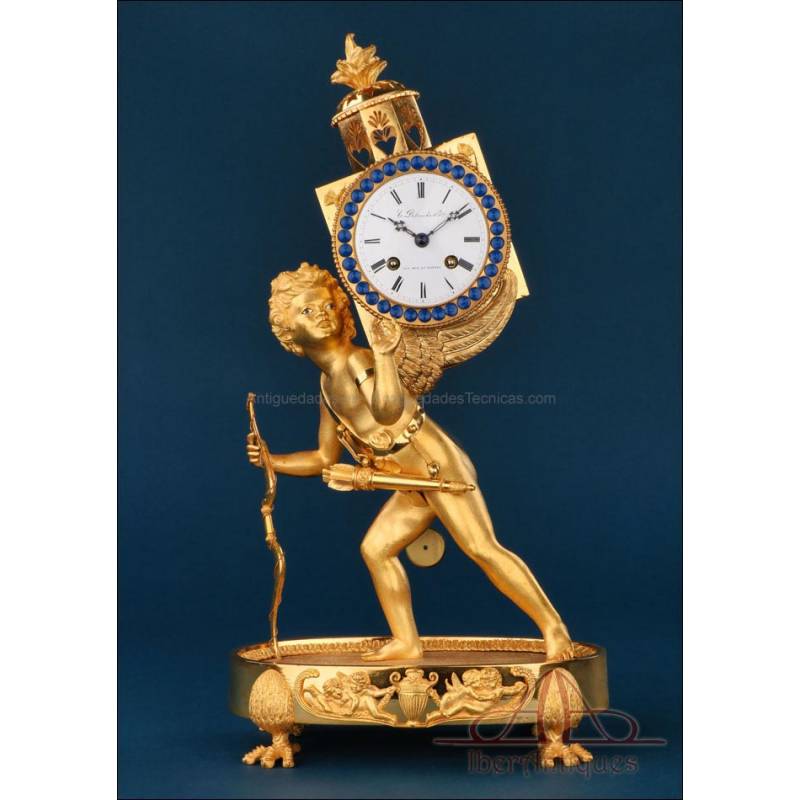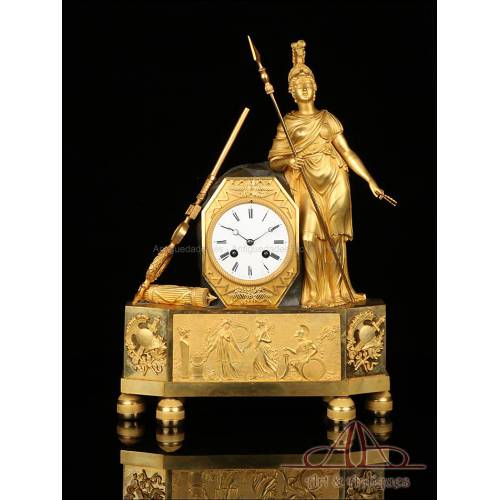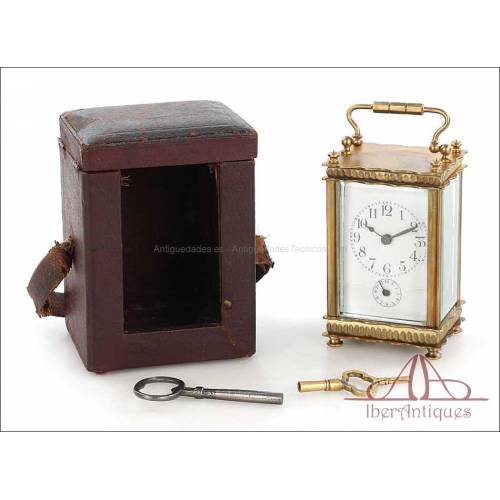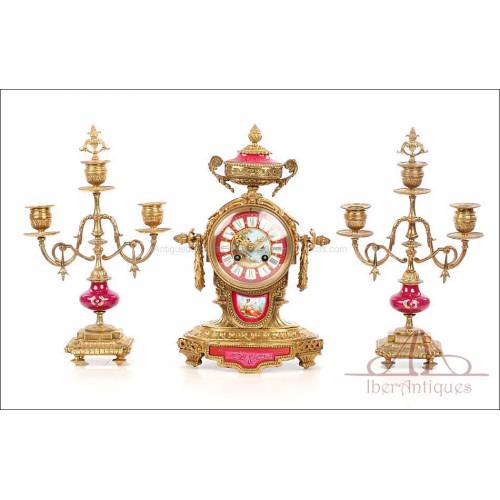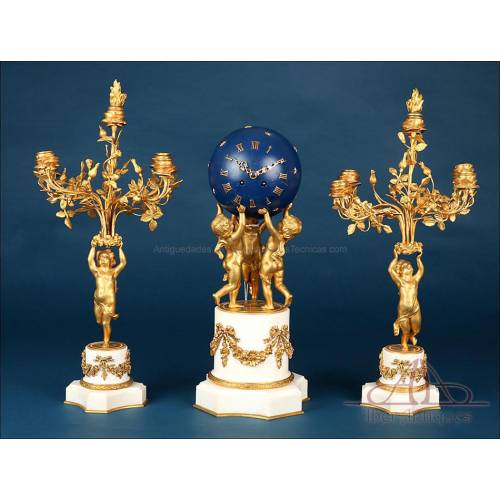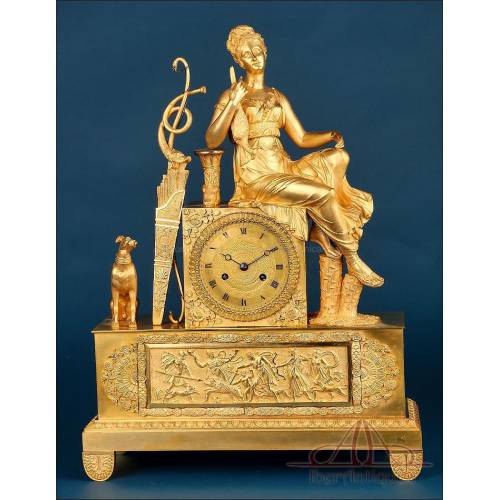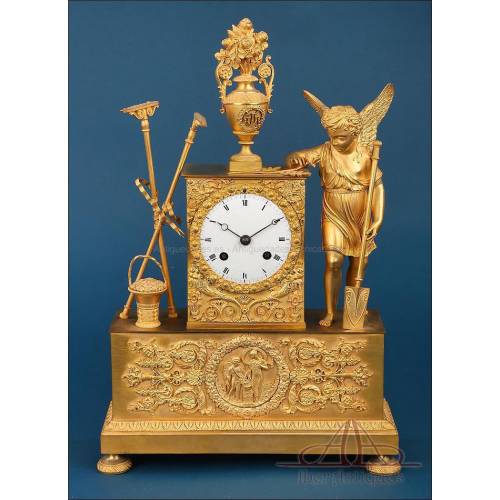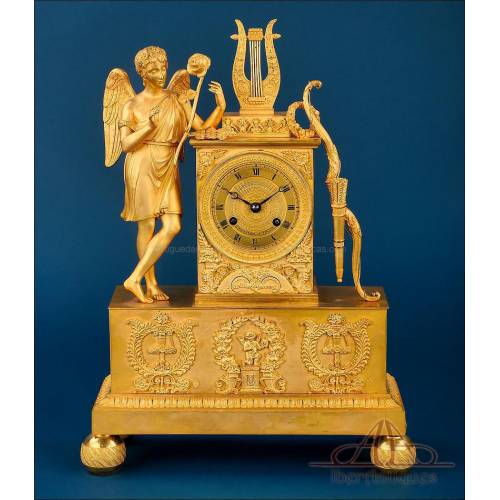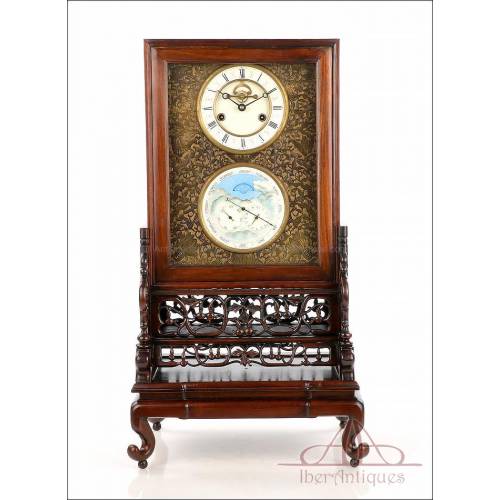E-288
'The Magic Lantern', Antique Empire Gilded Bronze Clock, France, XIX cent.
Rare French clock in mercury-gilded bronze, signed by Detouche, Paris. Eros with magic lantern. Fully restored. Circa 1850.
Antique Empire Gilded Bronze Clock ‘The Magic Lantern’. France, XIX cent.
A truly exceptional sculptural work, this mantel clock known as “The Magic Lantern” is crafted in mercury-gilded bronze and executed in the purest Empire style. This French piece, signed on the dial and movement by the prestigious clockmaker Constantin-Louis Detouche, follows an original design attributed to the celebrated Parisian bronzier Jean-Simon Deverberie, renowned for his symbolically rich and technically refined creations.
More than a timepiece, this clock is a poetic representation of love and the illusion of time. The central figure is Eros, the god of love, shown walking forward with purpose, carrying a bow and quiver, and bearing a magic lantern upon his wings. This laterna magica, or magic lantern, was an optical instrument developed in the 17th century that projected visual illusions. Here, it is transformed into a clock, cleverly alluding to the fleeting and illusory nature of time.
The sculptural composition is captivating: Eros gestures directly toward the dial as if warning the viewer that time, like the projections of a lantern, is only an illusion. His body and expression are modeled with great naturalism, and the entire scene is enriched with allegorical elements: the lantern is topped with a flaming torch pierced with stars and hearts, and the oval base is decorated with two cherubs playing around a classical urn. The entire piece stands on eagle claw feet, a strong nod to the aesthetics of the Empire style, imparting a sense of dignity and strength.
The white enamel dial with Roman numerals is signed “C. Detouche Bte. 160 Rue St. Martin”, and is framed by a bezel adorned with beautifully preserved cobalt blue enamel rosettes. The high-precision movement features an anchor escapement, silk suspension, and external count wheel. It strikes the hours and half-hours on a bell. The clock has been fully restored and professionally serviced. It is offered complete with its original pendulum, bell, and winding key.
As for its condition, this clock is perfectly restored, with a warm, uniform mercury gilding and no visible losses. The sculpture remains flawless, free of cracks or deterioration. A clock of this caliber is not only an exceptional work of art but also a solid investment for the discerning collector.
This is a majestic piece, ideal for enhancing a classical interior or serving as the centerpiece of a 19th-century sculptural clock collection. Its symbolism, technical execution, and dual attribution to Detouche and Deverberie make it a truly unique and distinguished creation.
A rare opportunity to acquire a masterwork of French sculptural horology.
Dimensions: 47 x 24.5 x 12.5 cm (18.5 x 9.65 x 4.92 in).
History of Constantin-Louis Detouche
Constantin-Louis Detouche (1810–1889) was one of the most influential French clockmakers of the 19th century. Celebrated for his technical precision and refined artistic sense, Detouche was appointed official clockmaker to both the city of Paris and Emperor Napoleon III. His workshop, located at 158 and 160 Rue Saint-Martin, became one of the most important horological centers in Europe.
Detouche’s reputation extended far beyond France. He was awarded gold medals at the Universal Exhibition in Besançon (1860) and again in London (1862), where his firm was praised for the excellence of its chronometers, regulators, and mathematical mechanisms. In 1853, he was awarded the Legion of Honour, and later received the Order of the Dannebrog from the King of Denmark for his innovations, including the famous electric clock.
Detouche was also a key figure in advancing horological science and education: in 1887, he financed the third edition of Claude Saunier’s landmark treatise Traité d’Horlogerie Moderne Théorique et Pratique, considered one of the foundational works of modern clockmaking. His firm also collaborated with the renowned illusionist Jean-Eugène Robert-Houdin to produce advanced mechanical devices of exceptional artistic value.
Among Detouche’s most prestigious creations were astronomical regulators of impressive complexity and beauty, one of which was long displayed at the corner of Rue Saint-Martin and Rue de Rivoli, and is now held by the François-Paul Journe Manufacture in Geneva. Detouche's legacy is synonymous with elegance, innovation, and craftsmanship, and his timepieces, such as the one presented here, remain prized by collectors and horological connoisseurs alike.
History of Jean-Simon Deverberie
Jean-Simon Deverberie (1764–1824) was one of the most imaginative and distinctive bronze artists and designers of late 18th- and early 19th-century Paris. Known for his bold creativity and unmistakable style, Deverberie was a pioneer in introducing new aesthetic languages into French decorative arts, blending neoclassical motifs with exotic, allegorical, and theatrical themes. Although he worked during the transition from the Louis XVI period to the Empire, his artistic maturity anticipated the eclectic decorative spirit of the 19th century.
He established his workshop in Paris at 14 rue Barbette and later at 5 rue des Fossés-du-Temple, where he designed and assembled clocks, candelabra, decorative sculptures, and luxury furnishings. One of his most significant achievements was the introduction of the African or American female figure as sculptural supports for clocks, a radical innovation at the time, which led to the creation of his famous “l’Afrique” and “l’Amérique” models. These works, commonly referred to as “pendules au nègre,” are now housed in prestigious collections such as the Louvre, the Musée des Arts Décoratifs, and the Getty Museum.
Deverberie’s work is characterized by meticulous attention to detail, mastery of gilded bronze, and a decorative vision that transcends mere function. He collaborated with renowned clockmakers to fit his sculptures with high-precision mechanisms, resulting in artistic timepieces of remarkable originality. Many of his creations were commissioned by the European aristocracy and wealthy bourgeoisie, attesting to his commercial success during his lifetime.
Jean-Simon Deverberie left behind an exceptional artistic legacy. His influence endured long after his death, and today his name is associated with some of the most refined and symbolically rich sculptural clocks in French horological history. The clock presented here, based on one of his designs, is a vivid example of his creative genius.

